engine coolant TOYOTA HIGHLANDER 2014 XU50 / 3.G User Guide
[x] Cancel search | Manufacturer: TOYOTA, Model Year: 2014, Model line: HIGHLANDER, Model: TOYOTA HIGHLANDER 2014 XU50 / 3.GPages: 712, PDF Size: 11.43 MB
Page 509 of 712
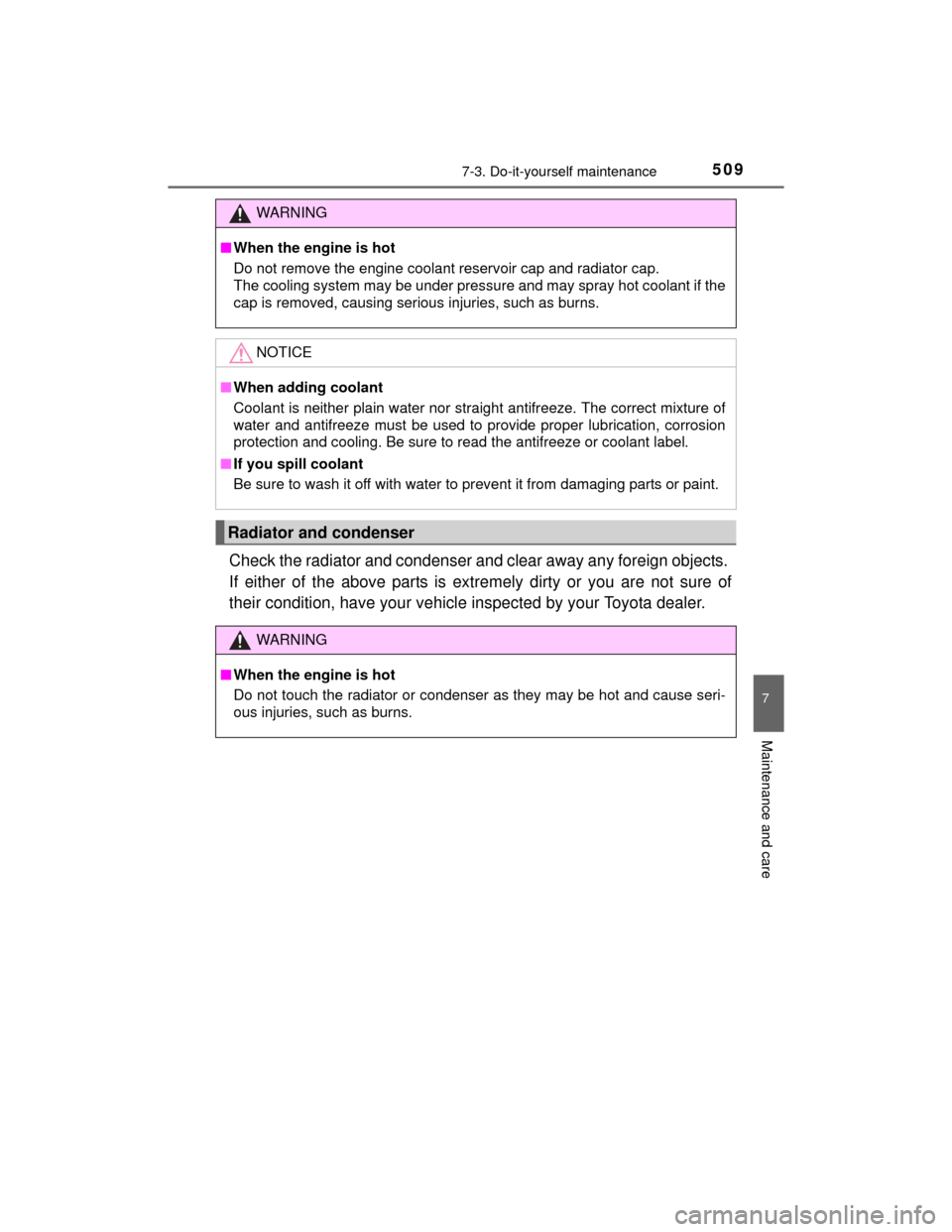
5097-3. Do-it-yourself maintenance
7
Maintenance and care
HIGHLANDER_U (OM48A12U)
Check the radiator and condenser and clear away any foreign objects.
If either of the above parts is extremely dirty or you are not sure of
their condition, have your vehicle inspected by your Toyota dealer.
WARNING
■When the engine is hot
Do not remove the engine coolant reservoir cap and radiator cap.
The cooling system may be under pressure and may spray hot coolant if the
cap is removed, causing serious injuries, such as burns.
NOTICE
■When adding coolant
Coolant is neither plain water nor straight antifreeze. The correct mixture of
water and antifreeze must be used to provide proper lubrication, corrosion
protection and cooling. Be sure to read the antifreeze or coolant label.
■ If you spill coolant
Be sure to wash it off with water to prevent it from damaging parts or paint.
Radiator and condenser
WARNING
■When the engine is hot
Do not touch the radiator or condenser as they may be hot and cause seri-
ous injuries, such as burns.
Page 561 of 712
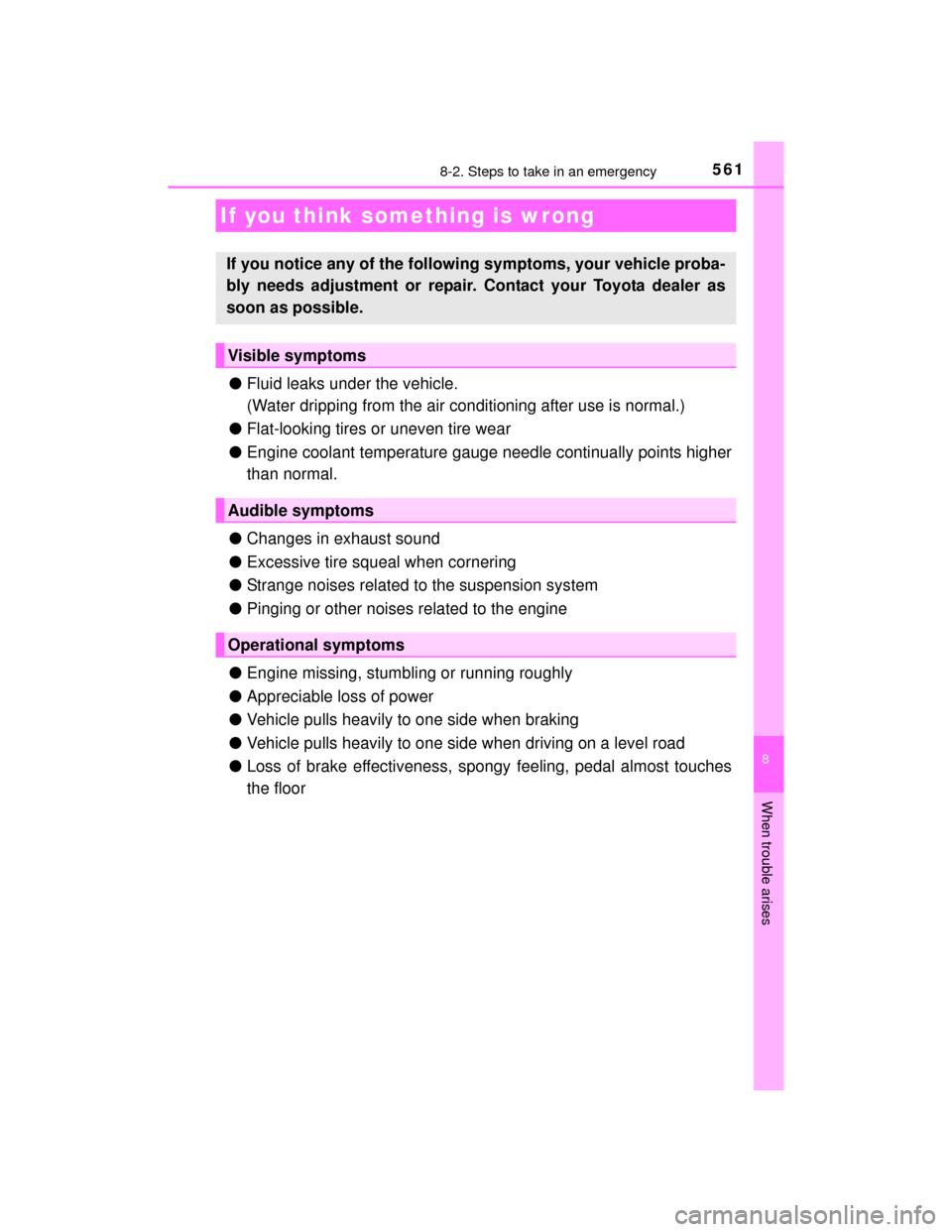
5618-2. Steps to take in an emergency
8
When trouble arises
HIGHLANDER_U (OM48A12U)
●Fluid leaks under the vehicle.
(Water dripping from the air conditioning after use is normal.)
● Flat-looking tires or uneven tire wear
● Engine coolant temperature gauge needle continually points higher
than normal.
● Changes in exhaust sound
● Excessive tire squeal when cornering
● Strange noises related to the suspension system
● Pinging or other noises related to the engine
● Engine missing, stumbling or running roughly
● Appreciable loss of power
● Vehicle pulls heavily to one side when braking
● Vehicle pulls heavily to one side when driving on a level road
● Loss of brake effectiveness, spongy feeling, pedal almost touches
the floor
If you think something is wrong
If you notice any of the following symptoms, your vehicle proba-
bly needs adjustment or repair. Contact your Toyota dealer as
soon as possible.
Visible symptoms
Audible symptoms
Operational symptoms
Page 578 of 712

5788-2. Steps to take in an emergency
HIGHLANDER_U (OM48A12U)
Color display only
Indicates that the engine coolant temperature is
too highA buzzer also sounds.
P. 626
Color display onlyIndicates a malfunction in the vehicle’s charging
system.
Immediately stop the vehicle in a safe place
and contact your Toyota dealer. Continuing
to drive the vehicle may be dangerous.
Color display only
(If equipped)
Indicates that the radar sensor is dirty or covered
with ice
A buzzer also sounds.
Clean the sensor.
Color display only
(If equipped)
Indicates that the dynamic radar cruise control
system is unable to judge vehicle-to-vehicle dis-
tance
A buzzer also sounds.
Turn off snow mode.
If the windshield wipers are on, turn them
off or set them to a mode other than high
speed wiper operation.
(If equipped)
Indicates that the LDA (Lane Departure Alert)
system is suspended (The camera sensor tem-
perature is higher than the operation temperature
range)
A buzzer also sounds.
Restart the LDA after driving for a while.
(If equipped)
Indicates that a Blind Spot Monitor sensor or the
surrounding area on the bumper is dirty or cov-
ered with ice
A buzzer also sounds.
Clean the sensor and its surrounding area
on the bumper.
Warning messageDetails/Actions
Page 626 of 712
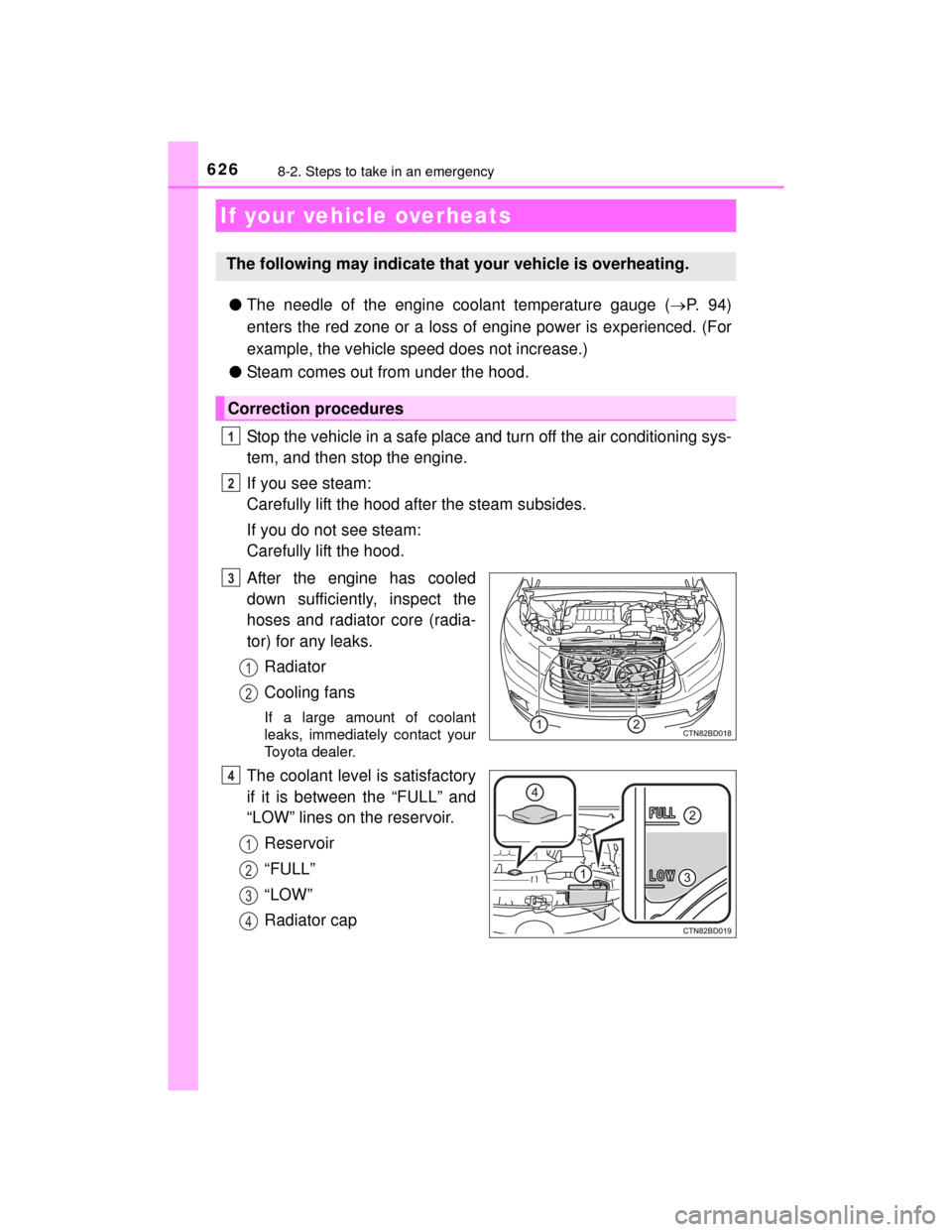
6268-2. Steps to take in an emergency
HIGHLANDER_U (OM48A12U)
●The needle of the engine coolant temperature gauge ( P. 9 4 )
enters the red zone or a loss of engine power is experienced. (For
example, the vehicle speed does not increase.)
● Steam comes out from under the hood.
Stop the vehicle in a safe place and turn off the air conditioning sys-
tem, and then stop the engine.
If you see steam:
Carefully lift the hood after the steam subsides.
If you do not see steam:
Carefully lift the hood.
After the engine has cooled
down sufficiently, inspect the
hoses and radiator core (radia-
tor) for any leaks.
Radiator
Cooling fans
If a large amount of coolant
leaks, immediately contact your
Toyota dealer.
The coolant level is satisfactory
if it is between the “FULL” and
“LOW” lines on the reservoir.
Reservoir
“FULL”
“LOW”
Radiator cap
If your vehicle overheats
The following may indicate that your vehicle is overheating.
Correction procedures
1
2
3
1
2
4
1
2
3
4
Page 627 of 712
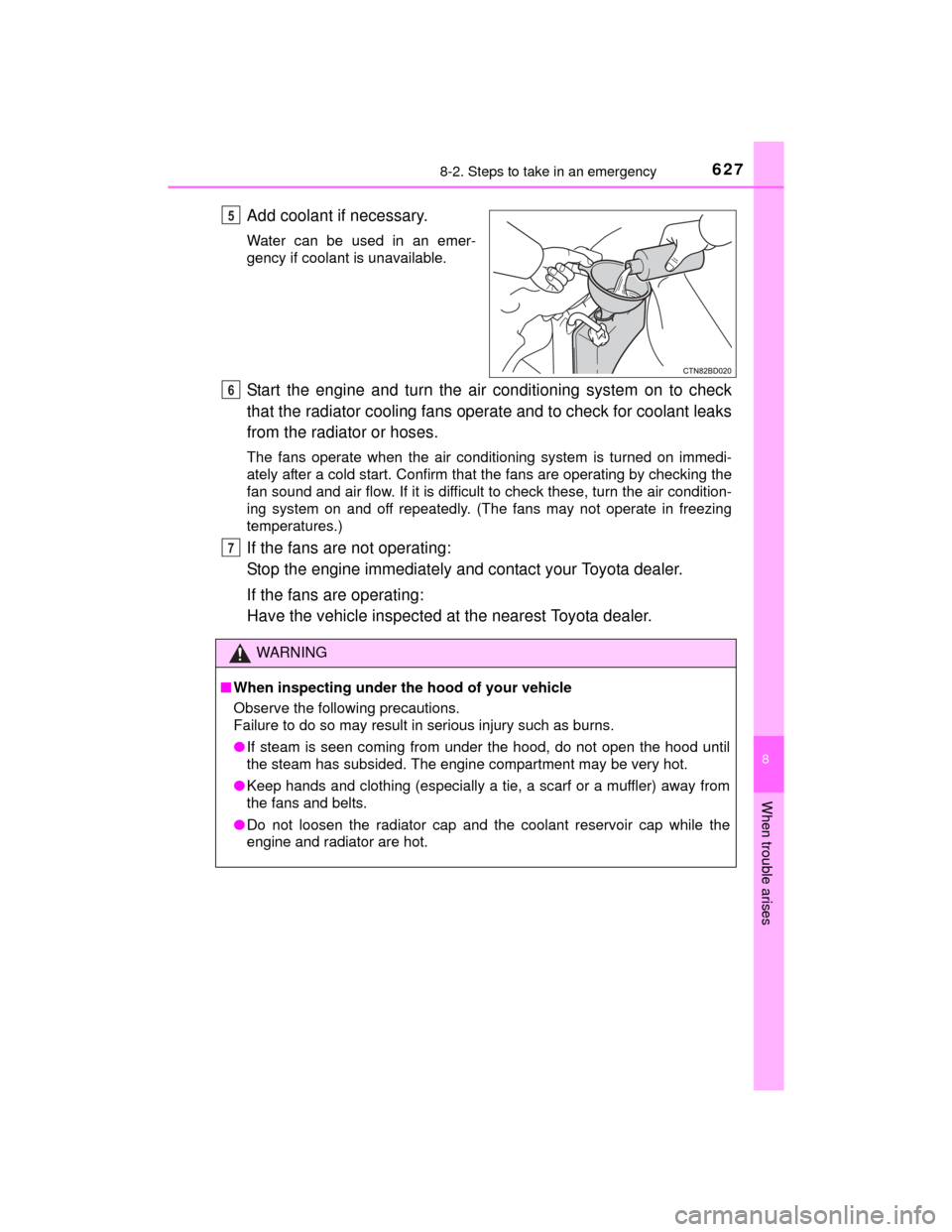
6278-2. Steps to take in an emergency
8
When trouble arises
HIGHLANDER_U (OM48A12U)
Add coolant if necessary.
Water can be used in an emer-
gency if coolant is unavailable.
Start the engine and turn the air conditioning system on to check
that the radiator cooling fans operate and to check for coolant leaks
from the radiator or hoses.
The fans operate when the air conditioning system is turned on immedi-
ately after a cold start. Confirm that the fans are operating by checking the
fan sound and air flow. If it is difficult to check these, turn the air condition-
ing system on and off repeatedly. (The fans may not operate in freezing
temperatures.)
If the fans are not operating:
Stop the engine immediately and contact your Toyota dealer.
If the fans are operating:
Have the vehicle inspected at the nearest Toyota dealer.
5
WARNING
■When inspecting under the hood of your vehicle
Observe the following precautions.
Failure to do so may result in serious injury such as burns.
●If steam is seen coming from under the hood, do not open the hood until
the steam has subsided. The engine compartment may be very hot.
● Keep hands and clothing (especially a tie, a scarf or a muffler) away from
the fans and belts.
● Do not loosen the radiator cap and the coolant reservoir cap while the
engine and radiator are hot.
6
7
Page 628 of 712

6288-2. Steps to take in an emergency
HIGHLANDER_U (OM48A12U)
NOTICE
■When adding engine coolant
Add coolant slowly after the engine has cooled down sufficiently. Adding
cool coolant to a hot engine too quickly can cause damage to the engine.
■ To prevent damage to the cooling system
Observe the following precautions:
●Avoid contaminating the coolant with foreign matter (such as sand or dust
etc.).
● Do not use any coolant additive.
Page 638 of 712
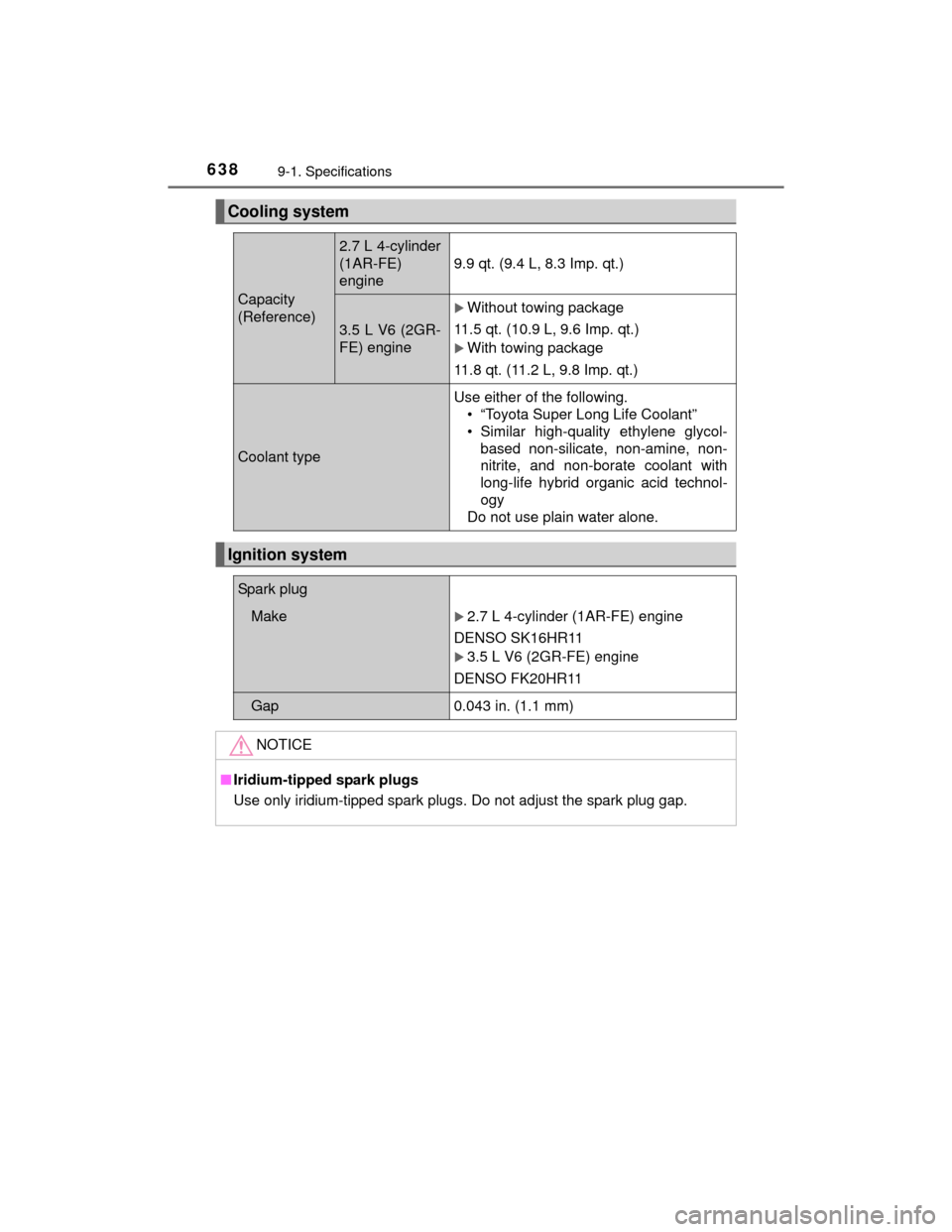
6389-1. Specifications
HIGHLANDER_U (OM48A12U)
Cooling system
Capacity
(Reference)
2.7 L 4-cylinder
(1AR-FE)
engine9.9 qt. (9.4 L, 8.3 Imp. qt.)
3.5 L V6 (2GR-
FE) engine
Without towing package
11.5 qt. (10.9 L, 9.6 Imp. qt.)
With towing package
11.8 qt. (11.2 L, 9.8 Imp. qt.)
Coolant type Use either of the following.
• “Toyota Super Long Life Coolant”
• Similar high-quality ethylene glycol-
based non-silicate, non-amine, non-
nitrite, and non-borate coolant with
long-life hybrid organic acid technol-
ogy
Do not use plain water alone.
Ignition system
Spark plug
Make2.7 L 4-cylinder (1AR-FE) engine
DENSO SK16HR11
3.5 L V6 (2GR-FE) engine
DENSO FK20HR11
Gap0.043 in. (1.1 mm)
NOTICE
■ Iridium-tipped spark plugs
Use only iridium-tipped spark plugs. Do not adjust the spark plug gap.
Page 656 of 712
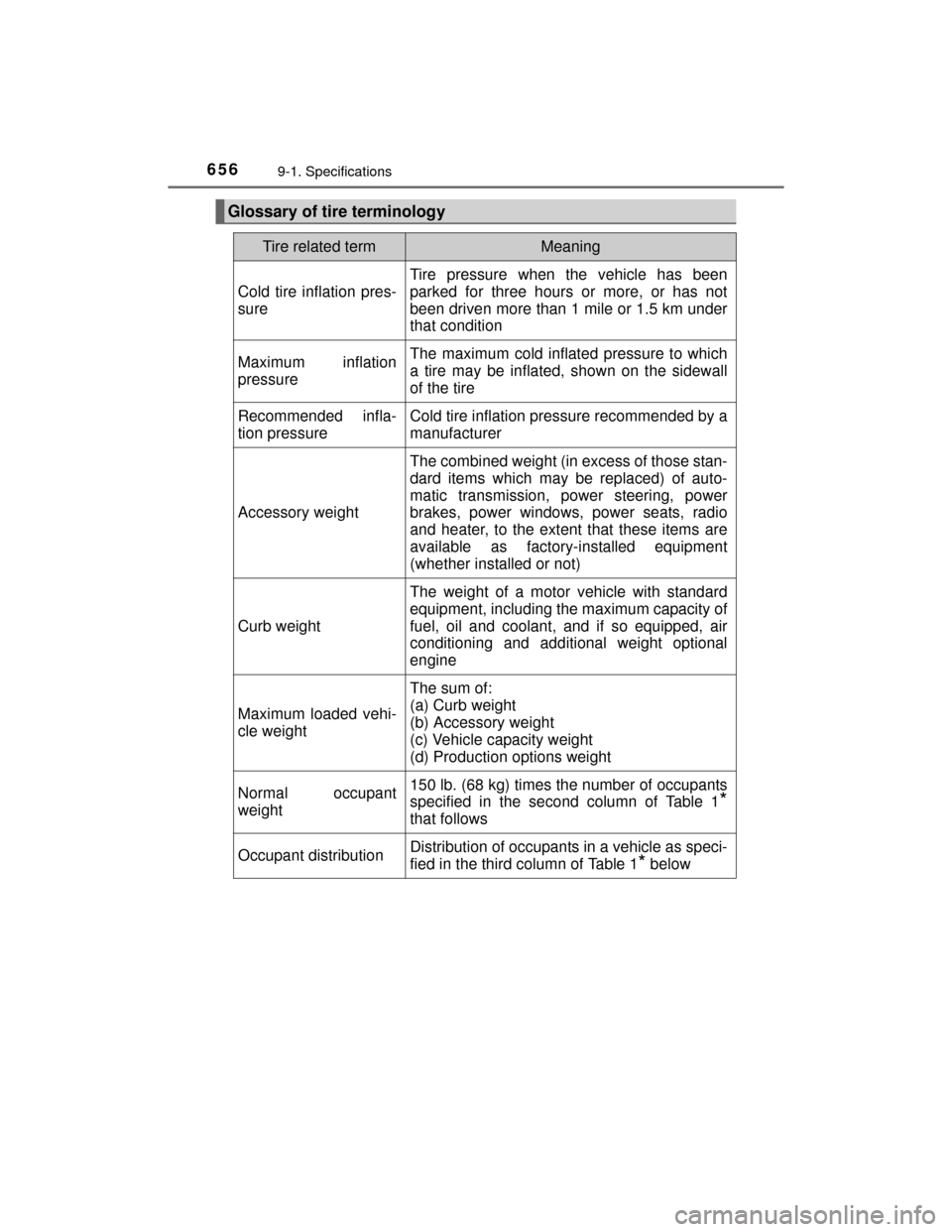
6569-1. Specifications
HIGHLANDER_U (OM48A12U)
Glossary of tire terminology
Tire related termMeaning
Cold tire inflation pres-
sure
Tire pressure when the vehicle has been
parked for three hours or more, or has not
been driven more than 1 mile or 1.5 km under
that condition
Maximum inflation
pressureThe maximum cold inflated pressure to which
a tire may be inflated, shown on the sidewall
of the tire
Recommended infla-
tion pressureCold tire inflation pressure recommended by a
manufacturer
Accessory weight
The combined weight (in excess of those stan-
dard items which may be replaced) of auto-
matic transmission, power steering, power
brakes, power windows, power seats, radio
and heater, to the extent that these items are
available as factory-installed equipment
(whether installed or not)
Curb weight
The weight of a motor vehicle with standard
equipment, including the maximum capacity of
fuel, oil and coolant, and if so equipped, air
conditioning and additional weight optional
engine
Maximum loaded vehi-
cle weight
The sum of:
(a) Curb weight
(b) Accessory weight
(c) Vehicle capacity weight
(d) Production options weight
Normal occupant
weight150 lb. (68 kg) times the number of occupants
specified in the second column of Table 1
*
that follows
Occupant distributionDistribution of occupants in a vehicle as speci-
fied in the third column of Table 1
* below
Page 699 of 712

699Alphabetical index
HIGHLANDER_U (OM48A12U)
Engine....................................... 635“ACC” position ...................... 225
Accessory mode ................... 229
Compartment ........................ 503
Engine switch................ 225, 228
Hood ..................................... 500
How to start the engine......................... 225, 228
Identification number ............ 634
If the engine will not start ...... 615
Ignition switch (engine switch) ........... 225, 228
Overheating .......................... 626
Engine coolant ......................... 508
Capacity ................................ 638
Checking ............................... 508
Preparing and checking before winter....................... 323
Engine coolant temperature gauge........................................ 94
Engine immobilizer system ...... 80
Engine oil ................................. 505 Capacity ................................ 636
Checking ............................... 505
Oil pressure warning light ..... 563
Oil pressure warning message ............................. 579
Preparing and checking before winter....................... 323
Engine switch .................. 225, 228
Enhanced VSC ......................... 298
EPS (Electric Power Steering)...... 299
Function ................................ 299
Warning light ......................... 564
Event data recorder (EDR) ........ 10 Flat tire ..................................... 590
Floor mats .................................. 26
Fluid
Automatic transaxle .............. 639
Brake .................................... 641
Washer ................................. 514
Fog lights ................................. 252 Replacing light bulbs ............ 539
Switch ................................... 252
Wattage ................................ 645
Front automatic air
conditioning system ............. 428
Front door courtesy lights Location ................................ 444
Wattage ................................ 645
Front fog lights ........................ 252 Replacing light bulbs ............ 539
Switch ................................... 252
Wattage ................................ 645
Front manual air conditioning system ............. 422
Front passenger occupant classification system .............. 53
Front personal lights............... 445 Wattage ................................ 645
Front seats ............................... 155 Adjustment............................ 155
Cleaning ............................... 487
Correct driving posture ........... 28
Driving position memory ....... 164
Head restraints ..................... 168
Seat heaters ......................... 442
Seat position memory ........... 164
Seat ventilators ..................... 442F